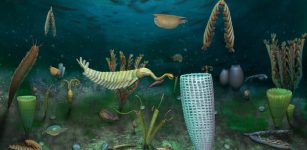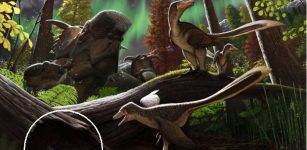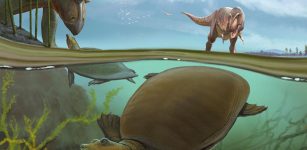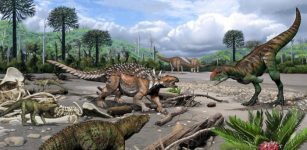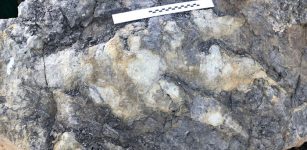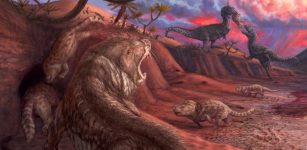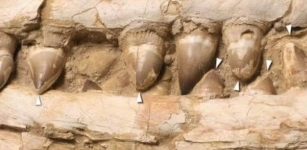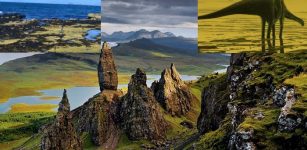Oldest Polar Sea Reptile Fossil Ever Found In Southern Hemisphere
Eddie Gonzales Jr. – MessageToEagle.com – The discovery of a 246-million-year-old nothosaur vertebra on New Zealand’s South Island has provided valuable insights into the early evolution of sea-going reptiles in the Southern Hemisphere. During the onset of the Age of Dinosaurs, New Zealand was situated on the southern polar coast of the vast Panthalassa super-ocean. This fossil represents the oldest known evidence of marine reptiles from this region.
Reconstruction of the oldest sea-going reptile from the Southern Hemisphere. Nothosaurs swimming along the ancient southern polar coast of what is now New zealand around 246 million years ago. Credit: Stavros Kundromichalis
Reptiles first ventured into the seas after a mass extinction event decimated marine ecosystems, paving the way for their evolutionary diversification around 252 million years ago. Before this find, evidence of this pivotal transition had only been uncovered in a few locations worldwide, such as Spitsbergen, northwestern North America, and southwestern China.
Despite being a single vertebra excavated from a stream bed boulder at the foot of Mount Harper, this remarkable discovery has shed light on the previously undocumented record of early sea reptiles in the Southern Hemisphere. It provides a unique window into the ancient marine ecosystems that existed during the dawn of the Age of Dinosaurs.
Reptiles reigned supreme in the seas for millions of years before dinosaurs conquered the land. Among the most diverse and geologically enduring group were the sauropterygians, boasting an evolutionary history of over 180 million years. This group encompassed the iconic long-necked plesiosaurs, which resembled the legendary Loch Ness Monster.
Preceding the plesiosaurs were the nothosaurs, distant ancestors of these marine reptiles. Nothosaurs could grow up to seven meters long and propelled themselves through the water using four paddle-like limbs. Their flattened skulls were adorned with a meshwork of slender, conical teeth, perfectly adapted for capturing fish and squid.
The discovery of the New Zealand nothosaur during a geological survey in 1978 was a significant event, although its true significance was not initially recognized. It was not until paleontologists from Sweden, Norway, New Zealand, Australia, and East Timor collaborated and combined their expertise to examine and analyze the vertebra and other associated fossils that this find was comprehended.
“The nothosaur found in New Zealand is over 40 million years older than the previously oldest known sauropterygian fossils from the Southern Hemisphere. We show that these ancient sea reptiles lived in a shallow coastal environment teeming with marine creatures within what was then the southern polar circle,” explains Dr. Benjamin Kear from The Museum of Evolution at Uppsala University, lead author on the study.
Original fossil of the New Zealand nothosaur vertebra. The oldest sea-going reptile from the Southern Hemisphere. Credit: Benjamin Kear
The oldest nothosaur fossils, dating back approximately 248 million years, have been discovered along an ancient northern low-latitude belt that extended from the northeastern to northwestern margins of the Panthalassa super-ocean. The origin, distribution, and timing of when nothosaurs reached these distant areas have been subjects of ongoing debate.
Some theories propose that they either migrated along northern polar coastlines, swam through inland seaways, or utilized currents to traverse the Panthalassa super-ocean. However, the recent discovery of a new nothosaur fossil in New Zealand has challenged these long-standing hypotheses, prompting a reevaluation of our understanding of their dispersal patterns.
Reconstruction of the New Zealand nothosaur. The oldest sea-going reptile from the Southern Hemisphere. Credit: Johan Egerkrans
“Using a time-calibrated evolutionary model of sauropterygian global distributions, we show that nothosaurs originated near the equator, then rapidly spread both northwards and southwards at the same time as complex marine ecosystems became re-established after the cataclysmic mass extinction that marked the beginning of the Age of Dinosaurs” says Kear.
“The beginning of the Age of Dinosaurs was characterized by extreme global warming, which allowed these marine reptiles to thrive at the South Pole. This also suggests that the ancient polar regions were a likely route for their earliest global migrations, much like the epic trans-oceanic journeys undertaken by whales today.
“Undoubtedly, there are more fossil remains of long-extinct sea monsters waiting to be discovered in New Zealand and elsewhere in the Southern Hemisphere,” adds Kear.
The paper is published in the journal Current Biology.
Written by Eddie Gonzales Jr. – MessageToEagle.com Staff Writer




